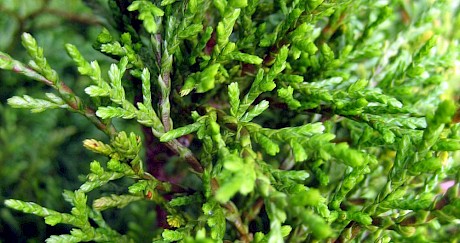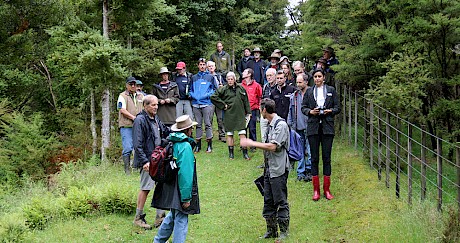Kamahi (Weinmannia racemosa)
(Kamahi is also known as “tawhero” in the Bay of Plenty and Waikato)
Introduction
Usually, when I come to write about an indigenous tree with potential for timber production, there is no problem sourcing enough information from the various books and journals that I have. Kamahi however is different; sometimes quoted as the commonest tree in the New Zealand bush, it has surprisingly been little studied or written about. There is little information about its early uses or the attributes of its timber. Because of its ability to grow well on many sites it is perhaps a tree worthy of inclusion in future planting trials. One area which appears to be fairly well understood is its ecology, since it is an important component of many forest types. Of the 18 major North Island forest types recorded by McKelvey and Nicholls, kamahi occurs in 16 and in about 50% of all the subtypes. By contrast rimu only appears in 10 major types although it is found in 50% of the sub types. The most prominent broadleaf, tawa, appears in 11 major types and 47% of the minor types.
History
The Maori use kamahi as a chest tonic if kumarahou is not available. It is given to people suffering from the flu, bronchitis and heavy chest colds; being boiled and drunk. The inner bark was boiled and the resulting decoction used to bathe wounds, burns, etc since it has antiseptic qualities, as well as accelerating healing. The tannic acid in the bark was used for dyeing; usually for dark black. The tannic acid from the bark reacts with the ferrous salts in the paru - the mud in certain swamps, etc. - to produce a strong and permanent black. With its high tannin content the bark was much used in earlier days by tanners, apparently being almost wiped out in the Auckland region.
Distribution
The Genus Weinmannia is widely distributed throughout the Southern Hemisphere, mainly in South America, Madagascar and the SW Pacific. Most species are sub-tropical. In New Zealand kamahi is found south of latitude 37° ( Te Aroha), while its northern cousin towai (W. sylvocola) grows from latitude 35° – 38° (Kaitaia to Whakatane). Kamahi grows up to 1000m altitude in the North Island and 900m in the south and is generally confined to areas with rainfall greater than 1000mm.
Tree size and growth
It is recorded in The Flora of New Zealand, Vol. 1 as growing to 25 metres tall and 1.2 metres in diameter, often with multiple trunks; towai is smaller. Kamahi often begins life as an epiphyte, growing on the trunks of wheki. It establishes early in regenerating scrubland and plays an important role in forest succession. Planted trees are recorded as having grown to 8.8 metres after 20 years (mai ca. 40 cm) and to 10 cm diameter over the same time (mai ca. 5 mm)
Timber
The timber is a hardwood without distinct growth rings and is noticeably heavy and close textured. It has been recorded as having been exported to the United Kingdom some 80 years ago where it is described as a wood of deep red colour, hard and strong with an ornamental grain. It was available in medium lengths up to 25 cm wide and used for cabinet making and ornamental work. Its density is between 600 and 720 kg / m³ and its specific gravity 0.72 (which is very high) but no other details are available. Clifton records it as having low durability (< 5 years) but this figure may relate to sappy roundwood. Mortimer states that the wood is durable under damp conditions only. The timber is apparently attacked by pinhole borer but according to Mortimer it is treatable and has been used for fence posts, sleepers, house blocks and wharf piles.
Potential for continuous cover forestry
It is quoted as being a suitable nurse species, although not as a primary nurse, requiring to be planted under a cover of Coprosma, Coriaria Olearia or Hebe species. However once established it has the potential to nurse more important timber trees like rimu and is able to form a canopy or grow in shade as a sub-dominant. One of kamahi’s greatest attributes is its apparent ability to grow on a very wide range of sites, throughout most of New Zealand. It is however prone to possum damage since it appears to be one of the most palatable species.
Potential
Kamahi has potential in several areas. There would seem to be a place for it as a minor species in both planted and natural indigenous forest since it appears very amenable to management. It is also an important honey producer.
Research requirements
The very limited research into the potential of this species currently restricts its use on a wider scale. Some work should be done to determine the durability and other qualities of its timber since lack of knowledge here greatly restricts its use. Some planting trials are also needed over a range of sites and with a combination of other species.
References
- Anon 1925. An identification scheme for common woods of New Zealand. Te Kura Ngahere 1 (1) p 12 – 15.
- Allan H H. 1961. Flora of New Zealand Vol. 1 Government Printer Wellington
- Brooker S G, Cambie R C & Cooper R C 1981. New Zealand Medicinal Plants. Heinmann
- Brooker S G, Cambie R C & Cooper R C 1988. Economic native plants of New Zealand. Botany Division D.S.I.R
- Clifton N C 1990. New Zealand timbers GP Publications
- Cockayne L 1967. New Zealand plants and their story (4th Ed) R E Owen Govt printer.
- Corkhill T 1948. A glossary of wood. Nema Press Ltd, London. 656p
- Howard A L 1948. The timbers of the world. MacMillan & Co, London
- Mortimer J & B 1984. Trees for the New Zealand countryside. Silverfish
- Pardy G F, Bergin D O & Kimberley M O 1992. Survey of Native tree plantations. FRI Bulletin 175
- Pollock K M 1986. Plant materials handbook for soil conservation. Vol 3 Native plants. DSIR Misc. Publ. 95
Species profile by Ian Barton


